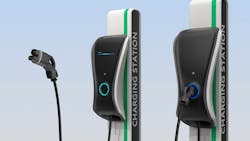States Greenlit to Move EV Charging Networks Forward
The Biden-Harris Administration yesterday announced it has approved Electric Vehicle Infrastructure Deployment Plans for all 50 states, the District of Columbia and Puerto Rico ahead of schedule under the National Electric Vehicle Infrastructure (NEVI) Formula Program, established and funded by President Biden’s Bipartisan Infrastructure Law. With this approval, all states now have access to all FY22 and FY23 NEVI formula funding, totaling more than $1.5 billion to help build EV chargers covering approximately 75,000 miles of highway across the country. The NEVI formula funding under the Bipartisan Infrastructure Law, which makes $5 billion available over five years, will help build an EV charging network across the country.
“America led the original automotive revolution in the last century, and today, thanks to the historic resources in the President’s Bipartisan Infrastructure Law, we’re poised to lead in the 21st century with electric vehicles,” said U.S. Transportation Secretary Pete Buttigieg. “We have approved plans for all 50 states, Puerto Rico and the District of Columbia to help ensure that Americans in every part of the country — from the largest cities to the most rural communities — can be positioned to unlock the savings and benefits of electric vehicles.”
The transportation sector is the country’s largest source of greenhouse gas emissions, according to the release from the Department of Transportation. President Biden has set an ambitious goal for half of all new vehicles sold in 2030 to be zero-emissions vehicles. Transitioning America’s cars to EVs is "an important pathway to achieving the President’s goal of reducing our emissions by 50-52% below 2005 levels by 2030, and a robust network of public chargers is an important tool to support this transition," the DOT statement read.
State Departments of Transportation (DOTs) were able to leverage technical assistance available through the Joint Office of Energy and Transportation and begin staffing and activities directly related to the development of their plans prior to approval. Now that EV charging plans from all 50 states, the District of Columbia and Puerto Rico have been approved, each state, territory, or district can be reimbursed for those costs and now have a wide range of options to use their NEVI Formula funding for projects directly related to the charging of a vehicle, including:
- Upgrade of existing and construction of new EV charging infrastructure
- Operation and maintenance costs of these charging stations
- Installation of on-site electrical service equipment
- Community and stakeholder engagement
- Workforce development activities
- EV charging station signage
- Data sharing activities
- Related mapping analysis and activities
All approved plans are available on the FHWA web site and funding tables for the full five years of the NEVI Formula program can be viewed here.
The NEVI Formula program is just one type of funding available to advance the electric vehicle future as part of President Biden’s climate and economic agenda. An FHWA guide on federal funding available for EV charging infrastructure is available here. Additional funding sources include:
- Ten percent of the NEVI Formula Program that is set aside each fiscal year for the Secretary of Transportation to help fill gaps in the national network through discretionary grants.
- The $2.5 billion Discretionary Grant Program for Charging and Fueling Infrastructure, which will ensure charger deployment meets the Biden-Harris Administration’s priorities, including equity commitments to increase EV charging access in rural, underserved, and overburdened communities.
- The Inflation Reduction Act, which will help bring down the sticker price of electric vehicles, providing tax credits to purchase new and used electric vehicles, as well as making an additional $3 billion accessible to support access to EV charging for economically disadvantaged communities through the Neighborhood Access and Equity Grant Program.
- The CHIPS and Science Act, which will bolster U.S. leadership in semiconductors, providing $52.7 billion for American semiconductor research, development, manufacturing and workforce development. This includes $39 billion in manufacturing incentives, including billions for the legacy chips used in automobiles.
- The cumulative $7 billion in funding to support an end-to-end domestic supply chain for domestic EV battery manufacturing available through the Department of Energy.
- The Reduction of Truck Emissions at Port Facilities Program, which will provide $400 million in competitive funding to reduce truck idling and emissions at ports, including through the advancement of port electrification.
FHWA is also working on related efforts to establish ground rules for how formula NEVI funds can be spent. FHWA published a Notice of Proposed Rulemaking (NPRM) on proposed minimum standards and requirements for projects funded under the NEVI Formula Program and plans to finalize that rulemaking expeditiously now that the comment period has closed. FHWA also proposed a Buy America waiver that will allow a short ramp up period for the domestic manufacturing of EV charging; the comment period for the waiver proposal is open through September 30, 2022. Additionally, FHWA has posted updated Frequently Asked Questions on its website.
Earlier this month, Gabe Klein was named as the Executive Director of the Joint Office of Energy and Transportation. The Federal Highway Administration and the Joint Office of Energy and Transportation will continue to provide direct technical assistance and support to States as they begin Plan implementation, as well as throughout the lifetime of the NEVI Formula Program. For more information on the NEVI Formula program, please visit FHWA’s NEVI web site and DriveElectric.gov. For more information on President Biden’s Bipartisan Infrastructure Law (BIL) and investments in electric vehicles, please visit FHWA’s BIL web site.
About the Author
T&D World Staff
Content Team
Nikki Chandler
Group Editorial Director, Energy
[email protected]
Jeff Postelwait
Managing Editor
[email protected]
Christina Marsh
Senior Editor
[email protected]
Ryan Baker
Associate Editor
[email protected]
Amy Fischbach
Electric Utility Operations
[email protected]
Rich Maxwell
Community Editor
[email protected]
Gene Wolf
Technical Editor
[email protected]
